Bjørnøya's wildlifeBy Øystein Overrein (ed.), Jørn Henriksen, Bjørn Fossli Johansen, Kristin Prestvold
You can register your observations of marine mammals around Svalbard in the Norwegian Polar Institute’s database Marine Mammals Sightings. 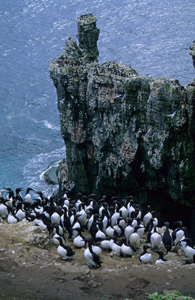
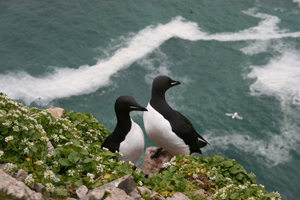
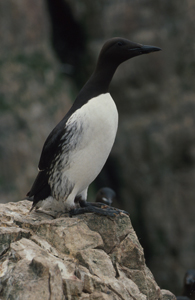
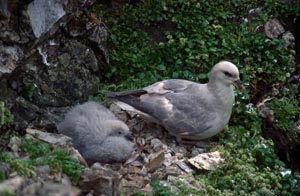
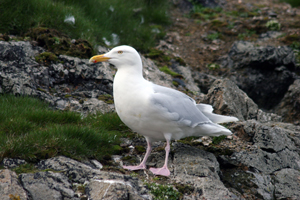
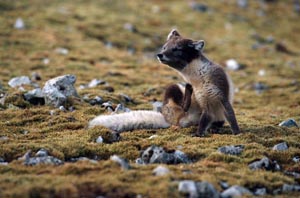
The seabird colonies in the south of Bjørnøya are among the largest found in the Northern Hemisphere. Almost 9 km of bird cliffs connect Glupen to Sørhamna. The island is like a magnet to seabirds, and it is estimated that over a million seabirds gather here during the breeding season. The most common species in the bird cliffs are common guillemot, Brünnich’s guillemot, little auk, black-legged kittiwake, northern fulmar and glaucous gull. The island is home to the world’s northernmost sizeable breeding colony of common guillemots, and also has one of the world’s northernmost colonies of razorbills. It is also the eastern boundary for the great northern diver (also known as the common loon). The sea areas around the island are important feeding grounds for the seabirds. This is largely due to the polar front – the area where cold water from the north and the east is mixed with warm and stratified Atlantic water – that often surrounds the island in the east, south and west. Due to the vertical mixing in the polar front area and the shallow seas that surround the island nutrient-rich deep-water is brought to the surface where it forms the basis for a high plankton production that fuels the rest of the food web. The most common phytoplankton (planktonic algae) groups are diatoms and flagellates, which are food for zooplankton, such as planktonic copepods and krill. From the early 1900s until World War II the population of guillemots on Bjørnøya were subjected to extensive egg hunting and even slaughtering of birds. The birds were used to feed fur-bearing animals on the mainland. After the war, egg hunting was regulated by quotas and harvesting seasons. On average, 43 000 eggs were collected annually between 1952 and 1961. This activity ended in 1970. In 1986 annual monitoring programmes were initiated for the populations of Brünnich’s guillemot, common guillemot, northern fulmar, black-legged kittiwake and glaucous gull on Bjørnøya. As early as 1987 a dramatic reduction in the breeding population of common guillemots was recorded. This happened at the same time as the collapse of the capelin stock, which was due to climate fluctuations as well as overharvesting. Through the course of one winter, the population of common guillemots was reduced from 245 000 pairs to 37 000 pairs. the population has grown since 1995, although numbers still remain far below those of 1986. Counts were carried out in 2006, indicating a current level of 70 000 pairs, about 28% of 1986 numbers. Today the population of Brünnich’s guillemot is at about 110 000 pairs. The northern fulmar breeds almost all along the Bjørnøya coastline, and in total 30 000 pairs were found breeding in 2006. A larger number of black-legged kittiwakes can be found as well, and approximately 125 000 pairs were breeding the same year. Bjørnøya has the largest number of glaucous gulls in the Barents Sea – in the summer of 2006 the breeding population was at about 600 pairs, but has decreased steadily over the past decade. The glaucous gulls are highly affected by the long-range transport of environmental pollutants such as PCB. Environmental pollutants affect the birds’ immune systems, their ability to reproduce and their behaviour. Bjørnøya is often visited by birds not usually found this far north. They are transported to the island by strong northerly winds. This is why 126 different species of birds have been seen on the island, of which only 33 have been registered as breeding there. Some of the breeding species are grey phalarope, Arctic skua, great skua, great black-backed gull, Arctic tern, black guillemot, razorbill, Atlantic puffin and long-tailed duck. Svalbard’s populations of pink-footed geese, barnacle geese and brent geese stop at Bjørnøya during their seasonal migration. At the south-bound migration in the autumn, nearly the whole population of barnacle geese land on Bjørnøya. Only very few pink-footed geese and barnacle geese actually breed here. The areas around Bjørnøya are important as nursery grounds for cod, haddock, saithe, herring, Norway redfish, Greenland halibut and American plaice. In total there are 24 fish species in these waters. Most of the Arctic whale and seal species can be found in the waters around Bjørnøya, but in smaller quantities than in other places around the islands of Svalbard. There are ringed seals, bearded seals, harp seals, hooded seals, harbour seals and walrus. The latter two are seldom seen, however. The walrus has not re-established itself after the last slaughtering in the 1820s. The most commonly observed types of whale are white-beaked dolphins and minke whales. If the drift ice stretches all the way to the island in winter, polar bears appear as well. Normally they go north with the ice as it begins to retreat in early spring, but once in a rare while a polar bear will remain on the island for a short amount of time before disappearing. The last time this happened was in 2004, when a female polar bear with two yearlings (most probably born in a den on the island) were observed in the north of the island as late as the end of June. Apart from the migrating birds, life on the island is pretty quiet. The population of Arctic fox has been low for quite some time due to hunting, but since 1986 breeding has been observed during several years. In the summer of 2006 at least three dens were in use. The increase in the fox population is manifested in growing losses of eggs, chicks and adult common guillemots, Brünnich’s guillemots and glaucous gulls in the accessible parts of the colonies. The glaucous gulls seem to be in the greatest danger. Two of the fox dens are situated close to large little auk colonies. Arctic char, sometimes of very high quality, can be found in approximately 20 lakes around the island. Thorough research has been carried out on Bjørnøya, especially in Laksvatnet, Øyangen and Ellasjøen to find out more about this fish and particularly its biology and the level and effects of persistent organic pollutants. Updated March 2015 |
The Cruise Handbook is also available in book formHard cover with numerous pictures - 249 pages - NOK 249.00 Norwegian Polar Institute |
 Norsk
Norsk